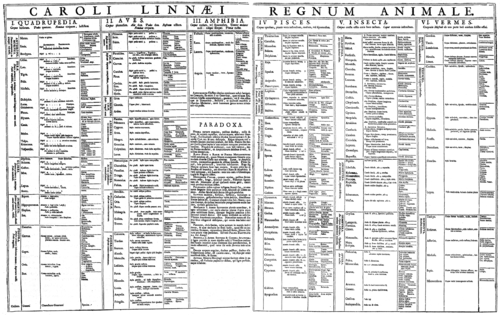| # | Animalia Paradoxa | Common name | Mythical? | Likely explanation or inspiration |
|---|
| 1 | Hydra | Lernaean Hydra | Mythical | Fabricated specimen (snake body with weasel teeth); [1] mythological basis in multi-headed serpents. Unrelated to the aquatic cnidarian. [6] |
| 2 | Rana-Piscis | Paradoxical frog | Real, misunderstood | Shrinks after tadpole stage; [1] misidentified due to reverse metamorphosis. |
| 3 | Monoceros | Unicorn | Mythical | Inspired by narwhal tusks; [1] myths influenced by horses and rhinos. |
| 4 | Pelecanus | Pelican | Real | Blood-feeding myth debunked; [1] accurate depiction of real pelicans. |
| 5 | Satyrus | Satyr | Mythical, possibly misidentified | Orangutan or ape may have been misidentified as mythical satyr; [6] based on medieval traveler accounts. |
| 6 | Borometz | Vegetable Lamb of Tartary | Mythical | Fern root artifact shaped like a lamb; [1] derived from the tree fern. |
| 7 | Phoenix | Phoenix | Mythical | Mythical rebirth bird; allegorically linked to the Date palm; [1] inspired by Egyptian Bennu bird. |
| 8 | Bernicla | Barnacle Goose | Real, misattributed | Medieval barnacle goose myth, linking geese to goose barnacles [8] |
| 9 | Draco | Dragon | Mythical | Jenny Haniver (taxidermied ray); [6] inspired by Flying lizards, rays, and bat-winged myths. |
| 10 | Automa Mortis | Deathwatch beetle | Real | Wood-boring beetle; [1] known for tapping sounds in wood. |
| 11 | Manticora | Manticore | Mythical | Persian legend hybrid of lion and porcupine; [9] mythical composite creature. |
| 12 | Antilope | Antelope | Real | Accurate description of real antelopes; [9] no mythical attributes. |
| 13 | Lamia | Lamia | Mythical | Mythology |
| 14 | Siren | Siren | Mythical, possibly misidentified | Manatee or dugong possibly misidentified as mythology sirens; [9] Other possible influences: mermaid folklore, seal sightings. |

